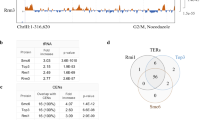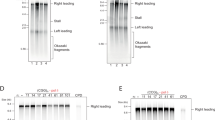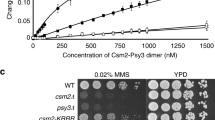Abstract
Faithful duplication of the genome requires structure-specific endonucleases such as the RuvABC complex in Escherichia coli. These enzymes help to resolve problems at replication forks that have been disrupted by DNA damage in the template. Much less is known about the identities of these enzymes in mammalian cells. Mus81 is the catalytic component of a eukaryotic structure-specific endonuclease that preferentially cleaves branched DNA substrates reminiscent of replication and recombination intermediates. Here we explore the mechanisms by which Mus81 maintains chromosomal stability. We found that Mus81 is involved in the formation of double-strand DNA breaks in response to the inhibition of replication. Moreover, in the absence of chromosome processing by Mus81, recovery of stalled DNA replication forks is attenuated and chromosomal aberrations arise. We suggest that Mus81 suppresses chromosomal instability by converting potentially detrimental replication-associated DNA structures into intermediates that are more amenable to DNA repair.
This is a preview of subscription content, access via your institution
Access options
Subscribe to this journal
Receive 12 print issues and online access
$189.00 per year
only $15.75 per issue
Buy this article
- Purchase on Springer Link
- Instant access to full article PDF
Prices may be subject to local taxes which are calculated during checkout








Similar content being viewed by others
References
Saintigny, Y. et al. Characterization of homologous recombination induced by replication inhibition in mammalian cells. EMBO J. 20, 3861–3870 (2001).
Higuchi, K. et al. Fate of DNA replication fork encountering a single DNA lesion during oriC plasmid DNA replication in vitro. Genes Cells 8, 437–449 (2003).
Saleh-Gohari, N. et al. Spontaneous homologous recombination is induced by collapsed replication forks that are caused by endogenous DNA single-strand breaks. Mol. Cell. Biol. 25, 7158–7169 (2005).
Wyman, C. & Kanaar, R. DNA double-strand break repair: All's well that ends well. Annu. Rev. Genet. 40, 363–383 (2006).
Hanada, K. et al. RecQ DNA helicase is a suppressor of illegitimate recombination in Escherichia coli. Proc. Natl. Acad. Sci. USA 94, 3860–3865 (1997).
Sonoda, E. et al. Rad51-deficient vertebrate cells accumulate chromosomal breaks prior to cell death. EMBO J. 17, 598–608 (1998).
Lundin, C. et al. Different roles for nonhomologous end joining and homologous recombination following replication arrest in mammalian cells. Mol. Cell. Biol. 22, 5869–5878 (2002).
Seigneur, M., Bidnenko, V., Ehrlich, S.D. & Michel, B. RuvAB acts at arrested replication forks. Cell 95, 419–430 (1998).
West, S.C. Molecular views of recombination proteins and their control. Nat. Rev. Mol. Cell Biol. 4, 435–445 (2003).
Baharoglu, Z., Petranovic, M., Flores, M.J. & Michel, B. RuvAB is essential for replication forks reversal in certain replication mutants. EMBO J. 25, 596–604 (2006).
Kogoma, T. Stable DNA replication: interplay between DNA replication, homologous recombination, and transcription. Microbiol. Mol. Biol. Rev. 61, 212–238 (1997).
McGlynn, P., Al-Deib, A.A., Liu, J., Marians, K.J. & Lloyd, R.G. The DNA replication protein PriA and the recombination protein RecG bind D-loops. J. Mol. Biol. 270, 212–221 (1997).
Xu, L. & Marians, K.J. PriA mediates DNA replication pathway choice at recombination intermediates. Mol. Cell 11, 817–826 (2003).
Sonoda, E., Hochegger, H., Saberi, A., Taniguchi, Y. & Takeda, S. Differential usage of non-homologous end-joining and homologous recombination in double strand break repair. DNA Repair (Amst.) 5, 1021–1029 (2006).
Kraus, E., Leung, W.Y. & Haber, J.E. Break-induced replication: a review and an example in budding yeast. Proc. Natl. Acad. Sci. USA 98, 8255–8262 (2001).
Davis, A.P. & Symington, L.S. RAD51-dependent break-induced replication in yeast. Mol. Cell. Biol. 24, 2344–2351 (2004).
Branzei, D. & Foiani, M. The DNA damage response during DNA replication. Curr. Opin. Cell Biol. 17, 568–575 (2005).
Heyer, W.D., Ehmsen, K.T. & Solinger, J.A. Holliday junctions in the eukaryotic nucleus: resolution in sight? Trends Biochem. Sci. 28, 548–557 (2003).
Boddy, M.N. et al. Mus81-Eme1 are essential components of a Holliday junction resolvase. Cell 107, 537–548 (2001).
Chen, X.B. et al. Human Mus81-associated endonuclease cleaves Holliday junctions in vitro. Mol. Cell 8, 1117–1127 (2001).
Kaliraman, V., Mullen, J.R., Fricke, W.M., Bastin-Shanower, S.A. & Brill, S.J. Functional overlap between Sgs1-Top3 and the Mms4-Mus81 endonuclease. Genes Dev. 15, 2730–2740 (2001).
Whitby, M.C., Osman, F. & Dixon, J. Cleavage of model replication forks by fission yeast Mus81-Eme1 and budding yeast Mus81-Mms4. J. Biol. Chem. 278, 6928–6935 (2003).
Osman, F., Dixon, J., Doe, C.L. & Whitby, M.C. Generating crossovers by resolution of nicked Holliday junctions: a role for Mus81-Eme1 in meiosis. Mol. Cell 12, 761–774 (2003).
Doe, C.L., Osman, F., Dixon, J. & Whitby, M.C. DNA repair by a Rad22-Mus81-dependent pathway that is independent of Rhp51. Nucleic Acids Res. 32, 5570–5581 (2004).
Fricke, W.M., Bastin-Shanower, S.A. & Brill, S.J. Substrate specificity of the Saccharomyces cerevisiae Mus81-Mms4 endonuclease. DNA Repair (Amst.) 4, 243–251 (2005).
Constantinou, A., Chen, X.B., McGowan, C.H. & West, S.C. Holliday junction resolution in human cells: two junction endonucleases with distinct substrate specificities. EMBO J. 21, 5577–5585 (2002).
Ciccia, A., Constantinou, A. & West, S.C. Identification and characterization of the human MUS81-EME1 endonuclease. J. Biol. Chem. 278, 25172–25178 (2003).
Ogrunc, M. & Sancar, A. Identification and characterization of human MUS81–MMS4 structure-specific endonuclease. J. Biol. Chem. 278, 21715–21720 (2003).
Abraham, J. et al. Eme1 is involved in DNA damage processing and maintenance of genomic stability in mammalian cells. EMBO J. 22, 6137–6147 (2003).
Interthal, H. & Heyer, W.D. MUS81 encodes a novel helix-hairpin-helix protein involved in the response to UV- and methylation-induced DNA damage in Saccharomyces cerevisiae. Mol. Gen. Genet. 263, 812–827 (2000).
Odagiri, N. et al. Budding yeast mms4 is epistatic with rad52 and the function of Mms4 can be replaced by a bacterial Holliday junction resolvase. DNA Repair (Amst.) 2, 347–358 (2003).
Boddy, M.N. et al. Damage tolerance protein Mus81 associates with the FHA1 domain of checkpoint kinase Cds1. Mol. Cell. Biol. 20, 8758–8766 (2000).
Doe, C.L., Ahn, J.S., Dixon, J. & Whitby, M.C. Mus81-Eme1 and Rqh1 involvement in processing stalled and collapsed replication forks. J. Biol. Chem. 277, 32753–32759 (2002).
Fabre, F., Chan, A., Heyer, W.D. & Gangloff, S. Alternate pathways involving Sgs1/Top3, Mus81/Mms4, and Srs2 prevent formation of toxic recombination intermediates from single-stranded gaps created by DNA replication. Proc. Natl. Acad. Sci. USA 99, 16887–16892 (2002).
McPherson, J.P. et al. Involvement of mammalian Mus81 in genome integrity and tumor suppression. Science 304, 1822–1826 (2004).
Dendouga, N. et al. Disruption of murine Mus81 increases genomic instability and DNA damage sensitivity but does not promote tumorigenesis. Mol. Cell. Biol. 25, 7569–7579 (2005).
Hiyama, T. et al. Haploinsufficiency of the Mus81-Eme1 endonuclease activates the intra-S-phase and G2/M checkpoints and promotes rereplication in human cells. Nucleic Acids Res. 34, 880–892 (2006).
Hanada, K. et al. The structure-specific endonuclease Mus81-Eme1 promotes conversion of interstrand DNA crosslinks into double-strands breaks. EMBO J. 25, 4921–4932 (2006).
Arnaudeau, C., Tenorio Miranda, E., Jenssen, D. & Helleday, T. Inhibition of DNA synthesis is a potent mechanism by which cytostatic drugs induce homologous recombination in mammalian cells. Mutat. Res. 461, 221–228 (2000).
Merrick, C.J., Jackson, D. & Diffley, J.F. Visualization of altered replication dynamics after DNA damage in human cells. J. Biol. Chem. 279, 20067–20075 (2004).
Courcelle, J., Donaldson, J.R., Chow, K.H. & Courcelle, C.T. DNA damage-induced replication fork regression and processing in Escherichia coli. Science 299, 1064–1067 (2003).
Magee, T.R. & Kogoma, T. Requirement of RecBC enzyme and an elevated level of activated RecA for induced stable DNA replication in Escherichia coli. J. Bacteriol. 172, 1834–1839 (1990).
Grompone, G., Ehrlich, D. & Michel, B. Cells defective for replication restart undergo replication fork reversal. EMBO Rep. 5, 607–612 (2004).
Masai, H., Asai, T., Kubota, Y., Arai, K. & Kogoma, T. Escherichia coli PriA protein is essential for inducible and constitutive stable DNA replication. EMBO J. 13, 5338–5345 (1994).
Kai, M., Boddy, M.N., Russell, P. & Wang, T.S. Replication checkpoint kinase Cds1 regulates Mus81 to preserve genome integrity during replication stress. Genes Dev. 19, 919–932 (2005).
Davies, S.L., North, P.S. & Hickson, I.D. Role for BLM in replication-fork restart and suppression of origin firing after replicative stress. Nat. Struct. Mol. Biol. 14, 677–679 (2007).
Essers, J. et al. Disruption of mouse RAD54 reduces ionizing radiation resistance and homologous recombination. Cell 89, 195–204 (1997).
Van Veelen, L.R. et al. Analysis of ionizing radiation-induced foci of DNA damage repair proteins. Mutat. Res. 574, 22–33 (2005).
Niedernhofer, L.J. et al. The structure-specific endonuclease Ercc1-Xpf is required to resolve DNA interstrand cross-link-induced double-strand breaks. Mol. Cell. Biol. 24, 5776–5787 (2004).
Acknowledgements
We thank C. Beerens for technical help. This work was supported by grants from the Dutch Cancer Society (KWF), the Netherlands Organization for Scientific Research (NWO), the European Commission (IP 512113) and by Cancer Research UK.
Author information
Authors and Affiliations
Contributions
K.H. generated the reagents and designed and carried out the experiments. M.B. carried out a number of the PFGE experiments and designed and carried out the FACS experiments. S.L.D. analyzed the DNA fiber experiments. E.v.D. and H.B.B. carried out and analyzed the chromosomal aberration experiments. H.O. carried out the Rad54 and Rad51 localization experiments. A.M. and J.E. were involved in generating ES cells. I.D.H. supervised the fiber experiments. R.K. advised on the design of the experiments. K.H., I.D.H. and R.K. were responsible for the preparation of the manuscript.
Corresponding author
Supplementary information
Supplementary Text and Figures
Supplementary Figures 1–3, Supplementary Tables 1 and 2, Supplementary Methods (PDF 2517 kb)
Rights and permissions
About this article
Cite this article
Hanada, K., Budzowska, M., Davies, S. et al. The structure-specific endonuclease Mus81 contributes to replication restart by generating double-strand DNA breaks. Nat Struct Mol Biol 14, 1096–1104 (2007). https://doi.org/10.1038/nsmb1313
Received:
Accepted:
Published:
Issue Date:
DOI: https://doi.org/10.1038/nsmb1313
This article is cited by
-
Replication fork uncoupling causes nascent strand degradation and fork reversal
Nature Structural & Molecular Biology (2023)
-
A multi-functional role for the MCM8/9 helicase complex in maintaining fork integrity during replication stress
Nature Communications (2022)
-
Mechanism of action of non-camptothecin inhibitor Genz-644282 in topoisomerase I inhibition
Communications Biology (2022)
-
FANCD2 promotes mitotic rescue from transcription-mediated replication stress in SETX-deficient cancer cells
Communications Biology (2022)
-
The benzylisoquinoline alkaloids, berberine and coptisine, act against camptothecin-resistant topoisomerase I mutants
Scientific Reports (2021)



